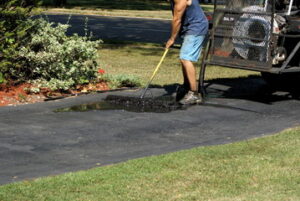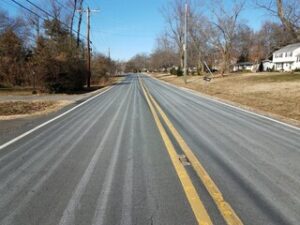A driveway in bad condition detracts from the curb appeal of a home. Fortunately, many homeowners can make simple repairs to restore their driveway’s beauty and functionality.

Small cracks should be repaired before they get larger under the weight of vehicles or become filled with water that freezes and expands. Homeowners can use crack repair filler to fix these areas. Contact Driveway Repair Charleston, SC for professional expertise.
If you have cracks in your driveway, it’s important to have them repaired. A smooth, damage-free driveway adds to your curb appeal, and homebuyers are willing to pay up to 7% more for homes that impress them at first glance. Additionally, cracked and damaged driveways are a safety hazard for drivers and pedestrians alike. If you see a crack in your driveway, it’s crucial to repair it as soon as possible to prevent it from getting worse.
Small cracks that are narrower than 1/4 inch are referred to as hairline cracks. These cracks may not be a sign of major problems, and they can be filled with a concrete patching compound. To apply this type of filler, first mist the surface of the driveway with water. This allows the sealant to bond with the concrete surface. Next, use a cold chisel or hand-drilling hammer to widen the crack slightly so that it will accept the patching material. After this, brush away any loose debris in the crack, and then mix up some asphalt patching blacktop and shovel it into the well-cleaned crack. Smooth the patch with a putty knife, and then wait for it to dry. The patch will take a few days to fully cure, but you should avoid driving on the surface during this time.
Large cracks that are wider than 1/2 inch should be treated with a different kind of repair. A professional can use a hydraulic cement to fill these cracks, and it’s best to hire one to do this job if you have a lot of these larger cracks. These cracks are caused by moisture and temperature changes in the concrete, and they can get even worse if not dealt with.
Wide fissures in your driveway are more serious than hairline cracks and need to be fixed immediately. They could indicate an underlying problem with the subbase or structure of the slab, and this will likely require professional evaluation and specialized repairs. Oftentimes, wide cracks are accompanied by heaving or settling, which means that the entire slab is in need of replacement.
Holes
Holes in your driveway can cause damage to cars and make driving dangerous. They also can be a big eyesore. If you have a lot of holes in your driveway it’s probably time to consider some type of resurfacing. Resurfacing is a more extensive project than patching, but it can help to completely rejuvenate your asphalt driveway and make it look like new.
To repair a pothole, start by removing any loose material from inside the hole. You should then be able to see clearly how deep the hole is and what the surface looks like. This will give you a good idea of the materials you’ll need to fill it and make the repairs.
If the surface of your pothole is just a little rough, you can use a bottle of crack filler to smooth it. This will take care of the small surface cracks and can be applied before sealing. Make sure you don’t overfill the cracks though as they may become visible under the sealant.
For a larger pothole you’ll want to use cold patch asphalt repair aggregate. You can purchase this at most home improvement stores or online. Most cold patch can cover a 12” x 12” x 1” hole per 10 lbs of aggregate. This is more than enough to cover a large pothole, but you’ll need to do some math to figure out how much you’ll need for your specific hole.
If you’re repairing something deeper than your asphalt layer, you’ll need to dig down a bit until you reach the subsoil. This can be pretty messy, so you’ll need to wear a dust mask and goggles. You’ll also need to clear out any rocks and other debris from the hole.
After you fill the hole with your aggregate, it’s important to compact the material. This will ensure that the repair holds firmly in place and isn’t easily displaced by passing traffic. This can be done with a tamper or by running over the area with your car.
If the hole is sunken into the ground, you’ll need to regrade the area and add base metal to bring it up to level with the surrounding pavement. This can be a major undertaking and will likely require professional help.
Sunken Sections
As time passes, a driveway is subjected to many environmental factors that can lead to it sinking or becoming uneven. These include soil erosion, ground movement, and heavy vehicle loading, especially from trucks or RVs. Fortunately, there are many ways that these issues can be addressed and corrected before they become significant problems that require costly repair or replacement.
The most obvious option is to replace the sunken concrete with a new section. This is a time-consuming process that requires the digging up of existing concrete and pouring a new slab in its place. It also leaves a noticeable color difference between the new and old concrete for quite some time. If you decide to pursue this method, it’s important that the existing concrete is clean and free of debris that can prevent a successful repair.
Another option is to resurface the entire driveway. This is a much quicker and less expensive solution, but there are some drawbacks to consider. The most significant is that it doesn’t address the underlying cause of the sinking, such as drainage or soil problems. This can lead to the problems returning in the future.
Other options include slurry injection or foam injection. These techniques use a high-density polyurethane material that is injected into the voids under the concrete. The foam expands and lifts the sunken sections back to their original position. It’s a great alternative to the more invasive and expensive methods of replacing your entire driveway or mudjacking.
It’s important to address these issues as soon as possible, before they worsen and cause further damage to your driveway or other concrete surfaces around your home. A professional contractor will be able to recommend the best method of repair for your individual needs. They will be able to inspect your driveway and determine the underlying cause of the damage. From there they can offer a variety of solutions to resolve your damaged concrete and protect it from further damage. They can even help you with some simple maintenance tips that can keep your driveway looking its best for years to come!
Rough Edges
The edges of a driveway need to be well taken care of, as they’re under more pressure than the rest of the pavement. This is why it’s important that you hire a reputable and honest contractor who will take the time to finish your driveway properly, including securing the edges. A sloppy job here could result in cracking and damage down the road.
One of the easiest ways to improve your driveway’s appearance is to install edging along its perimeter. These strips of concrete, clay, metal or plastic help to keep the driveway material in place and can also add a decorative touch. They can either stand up and offer a visual border to your driveway, or they can be buried so they’re flush with the surface of your driveway.
If you choose a concrete or stone option, you’ll need to install a layer of backfill prior to adding the edging. This helps to ensure that your edging is firmly secured, and it also prevents the backfill from washing away during heavy rainfall. Once the backfill is in place, you can set your chosen edging material. When choosing a type of edging, consider factors such as cost, durability and ease of installation.
Once you’ve installed your edging, you’ll need to compact it using a tamper or the back of your shovel. After that, you’ll need to rake and smooth the area to create a clean and professional-looking finished look. You should also treat any wood edging with a preservative to protect it from weathering and pests, which can cause it to degrade faster than other materials.
With proper care and maintenance, your edging will last for years to come. But don’t forget to sweep away any debris and periodically inspect your edging for signs of shifting or damage. If any sections are damaged or showing wear, it may be more cost-effective to replace them with new edging or consider repaving your entire driveway. After all, a cracked or worn-out asphalt surface can be a real eyesore. Plus, if it’s crumbling and uneven, the structural integrity of your driveway is compromised.
